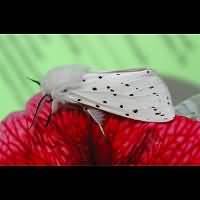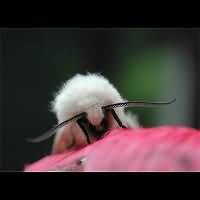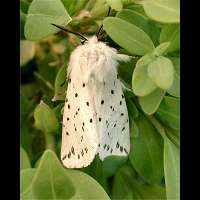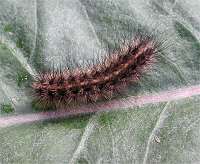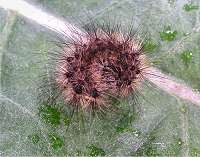White Ermine (Spilosoma lubricipeda)
The White Ermine is a hairy, white moth. Both frontwings and hindwings are speckled with black dots. The first part of the body is white and extremely hairy. The center part of the body is orange and black. The tip of the tail is white with a rather big black dot. The antennae are black and slightly combed. Well marked animals offer no problems when identifying them, but the number of black spots on the wings varies from just 3 to dozens and the size of the black dots is highly variable too. Animals which are almost unmarked can be mistaken for Water Ermine or the female of the Muslin Moth. Both are very similar. However the Water Ermine (a less frequent and rather local species) differs from the White Ermine by not having any black spots in the hind wing and the lack of the black dot in the white part of the tail. The female Muslin Moth differs from the White Ermine by having thin, wirelike and uncombed antennae, the lack of orange colouring on the body and the fact she's a bit smaller usually. The White Tiger also gives a more slender and taller impression compared to most other Ermines. Like other Ermines the wingspan is quite variable and is anything from 34 to 48 mm.
The eggs are deposited in large groups in summer. They hatch quickly, the caterpillars eat a lot and grow fast. The larvae are extremely mobile and are capable of covering large distances quickly, especially during the last instar. The scientific name of the species refers to this (lubricipeda = quickfooted). In autumn greyish black cocoons are wooven in which pupation takes place. The cocoons can be found among leaflitter and other plant debris. The caterpillar of the White Ermine is blackish brown with numerous small black warts on which shorter or longer hairs are growing. On the back is an orange or reddish dorsal line. The head is dark brown or black. The larvae will reach a length of 40 to 45 mm. They are extremely polyfagous, but prefer hairy plants. This is one of the very few species to eat Bracken.
The White Ermine is on the wing from May to the middle of August, but most numerous in June and the first half of July. Animals flying about later are usually of a second generation. The animal only flies during the night. Should you find one resting during the day, you can easily take some pictures as it hardly ever moves and never flies off. This is probably due to the fact that both adult and larva are foul tasting and even slightly poisonous for birds. Adult moths do not feed. Both males and females come to light readily. A very common and sometimes even numerous species all over Britain. Also very common on the continent.
The scientific name of this species is wrongly also written as Spilosoma lubricipedum.
The White Ermine is a hairy, white moth. Both frontwings and hindwings are speckled with black dots. The first part of the body is white and extremely hairy. The center part of the body is orange and black. The tip of the tail is white with a rather big black dot. The antennae are black and slightly combed. Well marked animals offer no problems when identifying them, but the number of black spots on the wings varies from just 3 to dozens and the size of the black dots is highly variable too. Animals which are almost unmarked can be mistaken for Water Ermine or the female of the Muslin Moth. Both are very similar. However the Water Ermine (a less frequent and rather local species) differs from the White Ermine by not having any black spots in the hind wing and the lack of the black dot in the white part of the tail. The female Muslin Moth differs from the White Ermine by having thin, wirelike and uncombed antennae, the lack of orange colouring on the body and the fact she's a bit smaller usually. The White Tiger also gives a more slender and taller impression compared to most other Ermines. Like other Ermines the wingspan is quite variable and is anything from 34 to 48 mm.
The eggs are deposited in large groups in summer. They hatch quickly, the caterpillars eat a lot and grow fast. The larvae are extremely mobile and are capable of covering large distances quickly, especially during the last instar. The scientific name of the species refers to this (lubricipeda = quickfooted). In autumn greyish black cocoons are wooven in which pupation takes place. The cocoons can be found among leaflitter and other plant debris. The caterpillar of the White Ermine is blackish brown with numerous small black warts on which shorter or longer hairs are growing. On the back is an orange or reddish dorsal line. The head is dark brown or black. The larvae will reach a length of 40 to 45 mm. They are extremely polyfagous, but prefer hairy plants. This is one of the very few species to eat Bracken.
The White Ermine is on the wing from May to the middle of August, but most numerous in June and the first half of July. Animals flying about later are usually of a second generation. The animal only flies during the night. Should you find one resting during the day, you can easily take some pictures as it hardly ever moves and never flies off. This is probably due to the fact that both adult and larva are foul tasting and even slightly poisonous for birds. Adult moths do not feed. Both males and females come to light readily. A very common and sometimes even numerous species all over Britain. Also very common on the continent.
The scientific name of this species is wrongly also written as Spilosoma lubricipedum.

